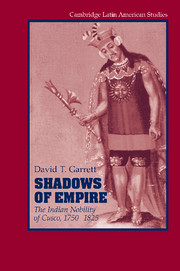Book contents
- Frontmatter
- Contents
- List of Illustrations
- Acknowledgments
- Pueblos Mentioned in Text
- Pueblos on Maps, by Province
- Introduction
- Part I INDIAN ELITES AND THE COLONIAL ORDER
- 1 Spanish Conquest and the Habsburg Reforms
- 2 The Long Seventeenth Century
- Part II THE INDIAN NOBILITY OF BOURBON CUSCO
- Part III CRISIS AND COLLAPSE
- Conclusion
- Appendix
- Glossary
- Bibliography
- Index
1 - Spanish Conquest and the Habsburg Reforms
Published online by Cambridge University Press: 19 October 2009
- Frontmatter
- Contents
- List of Illustrations
- Acknowledgments
- Pueblos Mentioned in Text
- Pueblos on Maps, by Province
- Introduction
- Part I INDIAN ELITES AND THE COLONIAL ORDER
- 1 Spanish Conquest and the Habsburg Reforms
- 2 The Long Seventeenth Century
- Part II THE INDIAN NOBILITY OF BOURBON CUSCO
- Part III CRISIS AND COLLAPSE
- Conclusion
- Appendix
- Glossary
- Bibliography
- Index
Summary
The dynamics of late colonial society determined the contours of the social space that Bourbon Cusco's Indian elites occupied, but the boundaries of that space were created in the 1500s through the interaction of three fundamental principles of Spanish rule in the Andes. First, the Habsburgs were committed to a legal and cultural boundary between Spanish and Indian Peru, the latter to be composed of self-governing rural communities, ideally off-limits to Spanish settlement. Second, under Philip II the monarchy aggressively pursued the integration of the Andes into the royal economy as a centralized, tributary colony, establishing the fundamental characteristic of the colonial highlands' political economy. Finally, the Habsburgs and their officials believed strongly in the existence of innate nobility, and that preconquest elites formed a natural nobility whose authority and privileges should enjoy recognition by the crown.
The reformist bureaucrats of the 1500s did not confront a tabula rasa in the Andes: the region was home to one of the great empires of the Americas, ruled by the Incas of Cusco. In the century before Pizarro's arrival in Peru they had conquered much of the Andes to forge an empire millions strong. In doing so they had confronted challenges similar to those that the Spanish would face, most importantly how to construct an imperial superstructure that drew labor and produce from the societies of the Andes to the service of empire. The political and economic relationship that supported this superstructure was tribute, and to organize its flow the Incas created a variegated Andean elite, composed of the Incas of Cusco and the ruling groups of subject societies.
- Type
- Chapter
- Information
- Shadows of EmpireThe Indian Nobility of Cusco, 1750–1825, pp. 15 - 44Publisher: Cambridge University PressPrint publication year: 2005



